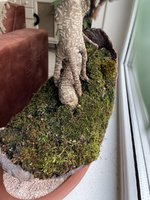NeedlesAndLeaves
Shohin
So I am still trying the best way to grow and keep moss on the soil.
I grounded up moss and added it to the soil without succes. Planted parts of moss on the soil but they did not last. After that I mixed grounded (wet) spagnum with grounded (dried) moss and sprinkled it on the soil, with only minor succes.
The soil in the pots is mostly akadama, pumice and lava mix.
I live in the Netherlands so the weather is mostly bad enough to grow moss on your own car.
Any thoughts or ideas on the matter?
Tnx Jasper
I grounded up moss and added it to the soil without succes. Planted parts of moss on the soil but they did not last. After that I mixed grounded (wet) spagnum with grounded (dried) moss and sprinkled it on the soil, with only minor succes.
The soil in the pots is mostly akadama, pumice and lava mix.
I live in the Netherlands so the weather is mostly bad enough to grow moss on your own car.
Any thoughts or ideas on the matter?
Tnx Jasper








